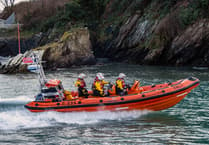Imagine a marsh in a river estuary slowing tidal flow. Now imagine the same thing but, artificial and deployable and removable.
My proposal is a hollow concrete, floatable and sinkable, raft on the same principles as the D-Day Mulberry floating harbour.
Tide-retarding material would cover its upper surface. Air would be pumped in to float it and vented to sink it.
It could be stored where convenient and then when a tidal surge is expected quickly deployed by floating it, towing it into position, and sinking it.
From observation of the tide when wading out to rocks normally underwater I have noticed that seaweed retards the flow of the tide both coming in and going out.
For Looe, it is the period of high tide that is especially damaging by coming up through the drains.
Yet it is mid-tides where tidal flow is fastest, around low and high tides the speed is lower as it is changing. If the hours immediately before to immediately after high tide could be slowed down would that not mitigate its effect?
Picture the flow of the tide from low to high tide and back again as a graph resembling in cross-section an inverted British Tommies helmet with the rounded top being high tide.
Then the soft flood defence in mind would change it to the shape of an inverted bowl, shallower and with a flat bottom, i.e. for those crucial few hours the tide would be slowed and not peak so high.
The artificial soft defence, simulating the seaweed or marsh, would be on the upper surface of the sunken “raft” streaming upwards underwater.
The material to be used, its thickness, height and area, and the dimensions of the raft bearing it are all factors that would need to be determined by experts to have the required effect.
One engineer in the flood defence consultation team suggested something like a vertical array of rollers like those on a car wash.
Short parallel walls would be required on the sides of the river at a suitable point along part of the extent of the Banjo pier in order to create a regular channel that the raft could rest in when in use. The bed of the river between these walls would need to be flattened.
Tidal “overtopping” or bypassing, and the slope of the side of the Banjo pier would need to be dealt with in the design.
Surely it wouldn’t be too difficult or costly to set-up a small mock-up or computer model to test the concept?
It is not a complete solution, assuming that the sea-level is rising annually, but I believe it could be a short term one - 20 or 30 years - giving time to agree and raise funds for one of the full flood prevention schemes.
We are so far along on the consultation for the seven or eight flood scheme options that it may be that there will be a tendency to ignore this suggestion on the grounds of “analysis paralysis”.
But this is a different solution and I notice that there is controversy and a petition about the existing schemes anyway -- so why not seriously consider this “stop-gap” one before leaping into the unknown and irrevocably selecting one of the larger schemes?





Comments
This article has no comments yet. Be the first to leave a comment.